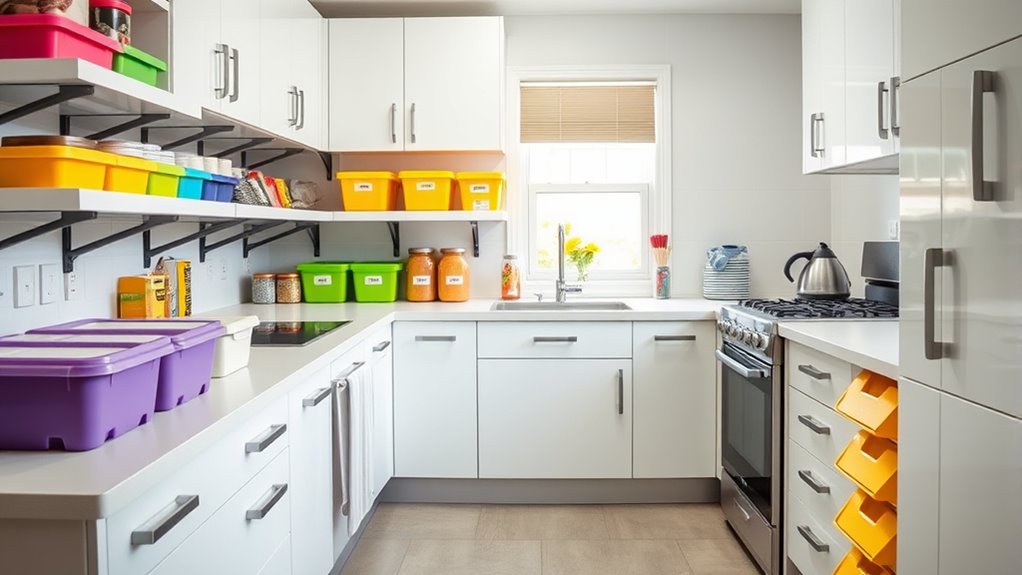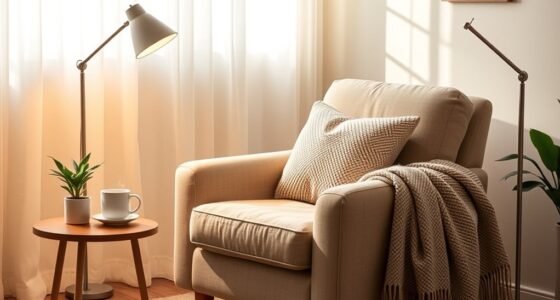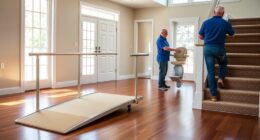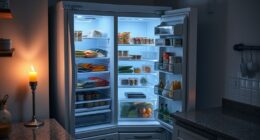To create a dementia-safe kitchen, incorporate clear visual cues like pictures on appliances and labels to help easy recognition. Use consistent placement for frequently used items to reduce searching. Bright, contrasting colors on cabinets and handles make it easier to identify zones and tools. Choose simple, safety-focused appliances with large controls and safety features. Proper lighting and clutter-free spaces boost visibility and safety. Keep exploring to discover more strategies that make kitchens safer and more supportive.
Key Takeaways
- Use clear, simple images and labels on cabinets and appliances to enhance recognition.
- Implement consistent placement of frequently used items to reduce searching and confusion.
- Apply bright, contrasting colors to cabinets, handles, and storage areas for easy identification.
- Choose user-friendly appliances with large controls and safety features to prevent frustration and accidents.
- Ensure bright lighting and maintain clutter-free surfaces to improve visibility and safety during kitchen tasks.
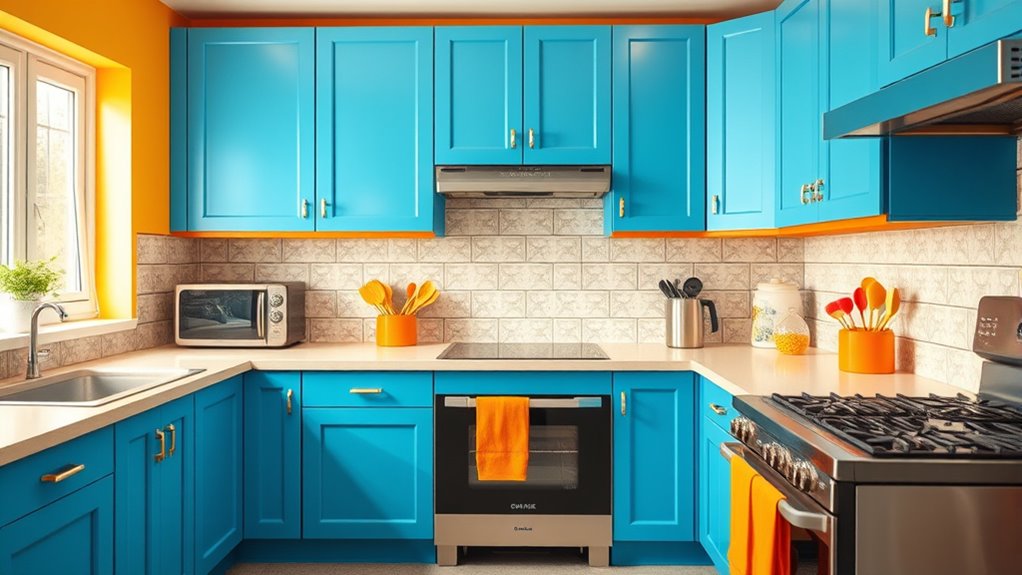
Creating a dementia-safe kitchen is essential for ensuring safety and independence for loved ones living with cognitive challenges. When you design the space thoughtfully, you help reduce risks and make everyday tasks more manageable. Visual cues play a crucial role here. Use clear, simple images or symbols on cabinets and appliances to indicate their purpose. For example, a picture of a coffee mug on the coffee maker or a plate on the microwave can help your loved one quickly identify the correct appliance. Consistent placement of everyday items also minimizes confusion—store frequently used items in easily accessible, designated spots so they know exactly where to find them.
Use simple images and consistent placement to help loved ones identify kitchen items easily.
Color coding is another effective strategy that can make a noticeable difference. Bright, contrasting colors on cabinets, drawers, and handles help distinguish different areas and items. For instance, painting cabinet doors in distinct colors or adding colored tape around handles can guide your loved one to the right place or appliance without guesswork. You might choose a specific color for utensils, dishware, or storage containers, which makes it easier for them to recognize and select what they need. The goal is to create visual differentiation so they can navigate the kitchen confidently without second-guessing or becoming overwhelmed.
When it comes to appliance choices, opt for user-friendly, simplified models. Look for appliances with large, easy-to-read controls and minimal settings. Avoid complicated features that might cause frustration or accidental misuse. For safety, consider appliances with automatic shut-off functions or those that are designed specifically for ease of use. For example, a stove with a front control panel or a microwave with large buttons can reduce the risk of operating errors. Additionally, installing safety features like stove knob covers or lockable oven doors can prevent accidental turns or openings. These adjustments not only keep your loved one safe but also foster their independence by enabling them to perform daily tasks without constant supervision.
Furthermore, color contrast can significantly enhance visibility, helping individuals distinguish between different surfaces and objects more easily. Keep in mind that lighting is vital. Ensure the kitchen is well-lit with bright, even illumination to prevent accidents. Avoid shadowy corners or overly dim areas that could cause missteps. Motion-activated or touch-sensitive lights can provide convenience and safety, turning on automatically when needed. Also, keep countertops clutter-free to minimize hazards and make it easier to prepare meals or perform tasks confidently.
Frequently Asked Questions
How Can I Personalize a Dementia-Safe Kitchen for Individual Needs?
You can personalize a dementia-safe kitchen by tailoring it to your loved one’s habits and preferences. Use familiar colors and clear labels on appliances and cabinets to help them identify items easily. Incorporate familiar utensils and routines to promote independence. Adjust the layout for easy access, and add personal touches like family photos or favorite items. Regularly observe their needs and update features to guarantee safety and comfort.
What Are the Best Non-Slip Flooring Options for Safety?
Non-slip flooring options are like safety nets under your feet. You should consider rubber, vinyl, or textured linoleum, as they provide excellent grip and reduce fall risks. These materials are durable, easy to clean, and can be customized to match your kitchen’s aesthetic. By choosing the right non-slip surface, you create a safer environment where your loved one can move confidently without worry.
How Do I Maintain Hygiene With Visual Cues and Color Coding?
To maintain hygiene with visual cues and color coding, you should clearly designate cleaning zones using bright, easily recognizable colors. Regularly monitor these areas to guarantee they stay clean and dry. Use visual reminders like labels or icons to prompt cleaning routines, and incorporate color-coded cleaning supplies to prevent cross-contamination. Consistently applying these cues helps you keep the kitchen hygienic and organized, reducing the risk of germs and accidents.
Are There Specific Brands or Products Recommended for Dementia-Safe Kitchens?
You should look for brands like Safe Kitchen, which specialize in dementia-friendly products, or consider appliances with clear labeling and simple controls, such as KitchenAid or Whirlpool. Non-slip mats, clearly labeled storage containers, and easy-to-use gadgets from brands like OXO can also help. Always choose products designed for safety, ease of use, and visibility, making your kitchen safer and more accessible for someone with dementia.
How Can Technology Assist in Creating a Safer Kitchen Environment?
Imagine a kitchen where smart sensors glow softly, alerting you if someone leaves the stove on or opens a dangerous cabinet. Technology helps by automating safety features—like timers that turn off appliances or voice-activated controls that reduce confusion. You can also install video monitors or emergency call systems, creating a secure environment. These tools give you peace of mind, making daily tasks safer and empowering independence.
Conclusion
Creating a dementia-safe kitchen with clear visual cues, color coding, and easy-to-use appliances can reduce accidents and boost confidence. Did you know that nearly 60% of seniors with dementia experience kitchen-related hazards? By making simple adjustments, you empower your loved ones to cook safely and independently. Small changes make a big difference, helping them stay safe and maintain their dignity. Start implementing these tips today for a safer, more supportive home.
